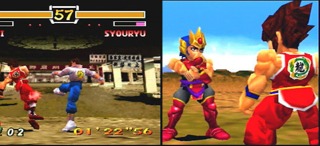Overview
 Two games in one.
Two games in one.Flying Dragon (not to be confused with the 1987 game Flying Dragon, and known in Japan as Hiryū no Ken Twin) is a 3D fighting game developed by Culture Brain and published for the Nintendo 64 in Japan (by Culture Brain on December 18, 1997), North America (by Natsume on July 31, 1998), and Europe (by Natsume on July 25, 1999).
Along with an updated version of the Japan-exclusive Sony PlayStation game Virtual Hiryū no Ken (albeit with a more limited roster), the game includes a 3D sequel to the Japan-exclusive Super Famicom game SD Hiryū no Ken. While the "Virtual" mode plays like a traditional arcade-style fighting game, the "SD" mode features simplistic movement and a special item-based system (where players can unlock and upgrade items to enhance their abilities). Both games feature a number of gameplay options that can be enabled or disabled (such as disabling side-stepping, turning the 3D fighter into a 2.5D one).
The SD mode was later spun-off into a Japan-exclusive sequel in 1999, titled SD Hiryuu no Ken Densetsu. This version adds new characters (some of whom are from the Virtual version), revamped game modes (including a new item system), and new gameplay changes.
Gameplay
For the most part, Flying Dragon plays like any post Street Fighter era fighter. There are basic combos that tend not to exceed 4 to 5 hits. The moves between characters differ between the games only if they're too outlandish to be featured in the more realistic styled fighter.
The chibi-styled fighter is by far the more substantial of the two experiences. It features a story mode with each character getting its own ending and several characters locked early on that need to be unlocked. Each match warrants a cash reward at the end which can be used to purchase or unlock various things in the game. In addition, there are unique items you unlock or purchase throughout this mode that you can equip to enhance your character in various ways such as a boost in speed, an additional move, superdefense, etc. Some can be used in-game such as health refillers or magic gauge fillers but have conditions such as only being usable once a match or requiring a full magic gauge.
Characters
Virtual Mode
Aleph, Dava, Kevin, Roseman, Wiler, and Yuuka do not return for this mode.
- Ryuhi
- Hayato
- Min Min
- Kate
- Shouryu
- Red Falcon
- Gengai
- Raima
- Ryumaou (final boss, unlocked either through password or after completing SD Mode with Ryumaou several times)
SD Mode
Log in to comment